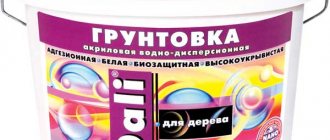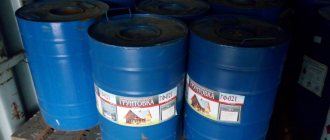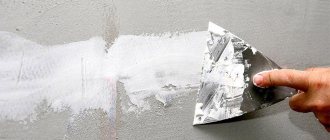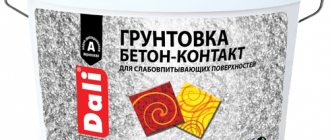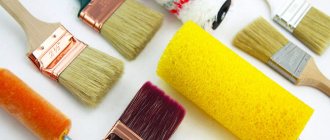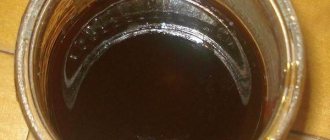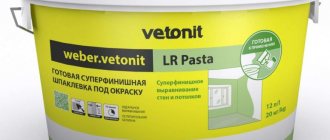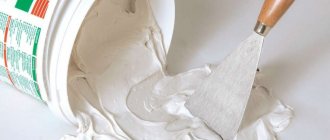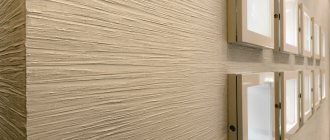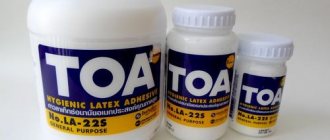Beton-House.com
Website about concrete: construction, characteristics, design. We combine the experience of professionals and private craftsmen in one place
Priming a concrete wall
Priming any surfaces before finishing is an indispensable condition for the installation of reliable and durable coatings. Concrete is no exception.
Let's figure out how important it is to treat concrete bases with a primer, what types of products are used for this, how primers for deep penetration concrete differ from other types, and also consider the technology for applying these compounds.
What it is?
By primer we mean a composition that, depending on its own components, affects concrete differently. This composition is understood in a container that is already ready for use. You can apply primer to the surface in different ways, for example, with a roller or brush. It is recommended to apply more liquid formulations using a sprayer, especially if the volumes are large.
The applied composition may differ depending on operating conditions, for example, external and internal. This is explained by how deep the primer penetrates and how much it can resist the effects of ultraviolet radiation, as well as frost, wind and other factors.
In any case, the composition is aimed at increasing the properties of concrete. This may be adhesion, sticking to other compounds, for example, tile adhesive or paint. All this is ensured by removing a layer of dust from the pores, or by treating with a special relief composition, which increases the adhesion of the tile to the surface.
Primer concrete-contact
The latter refers to the application of concrete contact, which contains granules of white sand and quartz, to which the tiles then adhere better. A similar deep penetration primer is used for lime walls, as well as other smooth materials.
Application rules
Working with primers is not difficult; anyone can handle the application if they follow the basic rules.
- Before starting priming, the base must be cleaned of dust, construction debris and oil stains.
- If there are metal elements on the surface, they must be cleaned of rust.
- Apply the primer with a roller or a wide paint brush, ensuring the uniformity of the layer.
- For large rooms, it makes sense to use a spray gun, which will help significantly reduce the work process.
- Primer compositions are sensitive to cold, so preparation of the base is carried out only at a temperature of 5...30 0C .
- Highly porous base, as well as large gaps and cracks, are sealed and primed in 2-3 layers .
- Each subsequent layer is applied after the previous one has completely dried.
Some primers require preliminary preparation, so they are diluted with water or solvent to obtain the optimal consistency. , a 1:1 ratio is usually used unless a different ratio is specified by the manufacturer.
Description and characteristics
Primer for concrete is almost always liquid. This is what determines the method of its application. For example, it can be applied by spray, brush or roller, which directly depends on the volume of work, density and other factors. Otherwise, the characteristics are determined by the specific type of product, where the following areas are distinguished:
- Polishes the surface. The surface of the concrete itself is only externally smooth. In fact, it consists of many small cells, which are then visible after painting. By using the right primer, we can polish out these pores or fill them, which improves the aesthetic properties after painting. This is convenient when painting a ceiling surface made of floor slabs.
- Protects against mold. This is relevant if the room is for utility purposes, which may not be heated at all or partially. The external aesthetics of the walls will improve as there will be no dark spots or fungal growths.
- Increases the adhesive ability of walls. This is relevant when tiles are glued to the walls. For example, here we use a concrete contact primer , which has a red or pink tint. Unlike the first characteristic, concrete contact coats the wall with an abrasive, rough compound, which increases adhesion.
- Increases the strength of concrete. This is especially true for concrete outside, as this is where it is exposed to moisture. By impregnating the surface with a primer, we close pores and microcracks. Therefore, water will not get here, which means that in winter, when freezing, there will be no destruction.
- We reduce the consumption of finishing materials. By using a primer, the consumption of paint, wallpaper and tile adhesive is reduced by approximately 25 percent. The primer itself is inexpensive, so its use allows you to reduce budget costs.
The main characteristic of the primer is the protection of the concrete itself. It envelops the surface with a protective layer, after which the natural moisture of the product is preserved, which ensures normal humidity of the walls.
Main types
Depending on the task you face when working with concrete, it is recommended to select different compositions. There are many varieties, so a few words need to be said about each:
A wall coated with primer does not absorb water
- Based on polystyrene. This primer is a solvent. It is aimed at removing dust and small debris from the surface, as well as minor polishing of small cracks and potholes, for the purpose of further application of paint. The use of this variety allows you to reduce paint consumption by 25 percent, improve overall aesthetics, and save your budget. The main thing is not to use such a primer for finishing walls inside, since its contents can have a toxic effect that affects the respiratory tract of residents.
- Based on polyvinyl acetate. Dries quickly, has a large area of use, suitable for walls and floors. After drying, it involves additional treatment of the walls with PVA glue, after which finishing can be continued.
- Based on epoxy resin. As in the previous version, the solvent is present in the mixture. This does not allow it to be used for residential premises, cellars for storing food, as well as greenhouses where flowers and plants will grow. On the other hand, such a primer is considered one of the best in terms of protecting concrete from destruction, especially from the outside.
- Alkyd primer. This option is only suitable for processing material externally. Removes dust and coats the concrete surface with a protective layer. A good primer, but with one drawback, it dries for at least a day.
- Acrylic based. This option positions itself as a primer for painting. This is the basis for concrete processing. It is colorless and odorless, since it does not contain chemically aggressive substances. It dries quickly and is inexpensive, which makes the soil accessible to the entire segment of buyers on the domestic market.
- Enamel based. Such processing tools appeared relatively recently, but quickly occupied their niche and are used in the treatment of walls from the inside and outside. External primer for concrete has its strong point - high adhesion.
- Deep penetration agents. Such compositions make the concrete stronger. For example, they are convenient if you have a concrete-based chimney and need to strengthen the outer walls to protect them from destruction. They penetrate up to 10 mm into concrete, are well absorbed, dry quickly, and are preparatory to further processing. One of the varieties of this option is soil containing quartz sand. It allows you to create a relief surface in concrete, which in the future increases adhesion to the base of porcelain stoneware or tiles, by applying a special glue to the concrete.
Polystyrene, polyvinyl acetate primers
Polystyrene primers contain solvents, so they are most often in demand for finishing facades and in industrial premises. The material creates a durable adhesive film with concrete and some specific types of paints. In addition, polystyrene primer does an excellent job of protecting the surface.
Polyvinyl acetate primers are also worthy of choice. This solution is perfect for subsequent concrete painting. Compositions of this type dry quickly and can be used for short work periods. Drying time is 30-40 minutes. The material provides a high degree of adhesion no worse than others.
Scope of application
One way or another, the use of primer for concrete concerns the construction sector. For example, when pouring a self-leveling floor, we know that its base includes not only pure liquid concrete. Therefore, the primer is applied over the surface. the deep primer of concrete that is used here , increasing strength.
Self-leveling floors are already poured onto a concrete base. And in order for them to adhere better, you should use a preparatory primer that will remove dust. Concrete walls in apartments, houses, garages, hangars also need to be treated. In this case, processing must be carried out from the inside and outside.
The principle of operation of primer for concrete
On the outside, we will increase the strength of the concrete, increase adhesion, and in the future we can paint or finish it with another material. From the inside, using a primer, they remove dust, then paint it, and if there are perfectly smooth walls, the result is impeccable. As for interior work, it is important to apply a primer to concrete before laying tiles and porcelain stoneware on it.
This is due to the fact that the surface of the base is smooth, so there is nothing for the glue to cling to. used for concrete contains quartz sand, making the surface textured, which facilitates further installation of tiles on vertical and horizontal walls. However, when laying tiles on the floor, you should not use concrete contact; you can get by with cheaper means that remove dust on the floor surface.
Universal penetrating primer for concrete
Compositions of this type are used for any density and grade of concrete. However, maximum performance is achieved on surfaces with increased porosity. The depth of soil penetration is 5-9 mm . In addition, the base immediately gains increased adhesive capabilities. The material is indispensable for protecting and strengthening loose, old concrete walls. Average consumption – 300 g/sq.m.
How to use it correctly?
There are three ways to apply the primer. This is done with a brush, roller, or sprayer. All this is indicated on the container with soil, since everything depends on the density and, if applied in an inappropriate way, there is a possibility of clogging the holes of the sprayer.
Most people work with a roller, pouring the soil into a container special for this purpose. This way you can do the job faster and saturate the base properly. In addition, the roller is quite economical, since almost nothing is spilled on the floor.
The brush will have to work in hard-to-reach places, such as the corners of walls and ceilings, near obstacles and other places. In this case, deep penetration concrete contact with quartz sand is more convenient to apply with a brush. It is expensive and is mainly used zonally, so when working with a brush, it is more convenient not to go beyond the limits.
The process of applying primer to concrete
Any soil is already supplied ready-made. Therefore, it is enough to deliver it, shake it, open the lid, pour it into a container convenient for use and use it for its intended purpose. There is no need to dilute with water, as you will reduce the amount of concentrate.
Alkyd
The cost of alkyd primers is 790-5600 rubles.
Main technical characteristics:
- type of work: external, internal, universal;
- tinting: possible;
- gloss level: matte;
- thinner: solvent.
Alkyd primers work not only on concrete, but also on natural stone
Peculiarities
The material is intended for external and internal work. The primer creates an adhesive bridge between the base and the finishing coating. This is the optimal solution for painting.
Method of application
Like all other primers, the composition is applied with brushes, sprayers, and rollers.
Consumption
Consumption refers to how much active substance will be spent when applied to the desired area. The approximate consumption is always indicated on the packaging, so making the correct calculation and not constantly traveling to the construction site is not so difficult.
Consumption depends on the density of the material and the higher it is, the higher the consumption. For example, concrete contact has the highest consumption, since about 150-300 grams will be used per square meter of surface. It cannot be diluted to save money. Regarding deep impregnation soil used to strengthen concrete, it is about 100 grams. “per square”, based on average calculations.
Universal primer for concrete
Preparatory soil has the lowest consumption, about 70 grams per 1 square meter. Acrylic primer for concrete consumes about 120-150 grams per square.
Price
The cost directly depends on the purpose, density and volume purchased. For example, a primer with the addition of quartz is expensive because expensive raw materials are used. We are talking about concrete contact, where for 200 grams of raw materials you will have to pay about 100 rubles.
Birss primer is universal, with a consumption of up to 230 g. per square meter, with a capacity of 10 kg, will cost about 500 rubles. It is profitable to buy in such a volume, since it will last a lot. The composition includes latex filler, which allows you to fill pores and remove dust from the surface.
Primer for concrete Ceresit ST17
In addition, the water-dispersion base is completely safe for indoor use. Water-dispersion primer is suitable for treating walls, floors, ceilings, and other concrete-based surfaces.
There is a deep absorption composition on sale, for example, Neolab. For a container of 5 liters you will have to pay around 200 rubles. The strengthening composition for the concrete floor “AK-02” Grid, weighing 27 kg, in a metal container, costs about 3,500 rubles.
Advantages and disadvantages
The main advantage is the low price of concrete primer . As you can see, for 500-1000 rubles you can prepare concrete well for further finishing, protect it from getting wet, and also deal with dust. Including, some types of impregnations involve strengthening concrete, which is important for walls and floors. Other benefits are as follows:
- Ready to use. Indeed, the impregnation is packaged from the factory the way you will use it. There is no need to dilute or study lengthy instructions. Just shake, if you are not talking about concrete contact, then apply with a roller, brush or spray.
- Large volume of operation. The use of impregnation, depending on the type, is associated with work inside and outside. These are floor and wall screeds, floor slabs and ceilings, steps, columns, chimneys and other places.
- Saves money. The use of a primer reduces the amount of paint applied, as well as tile and wallpaper adhesive. The result is better, less time is spent on work. All this reduces the planned estimate and saves the budget.
- Strengthens. If one screed is applied on top of another, especially if work is carried out with self-leveling floors, then a primer is required. It removes dust particles and increases the adhesion of the material, which increases the strength of the screed. Adhesion increases, the base is less exposed to moisture from the soil.
- Easy to apply. Application does not require much experience. Just don't be afraid to try and you can save a lot of money at work.
There are almost no disadvantages. Perhaps this may include the long drying period and unpleasant odor inherent in some species. The latter makes such impregnation for concrete unsuitable for indoor use. There may be toxic impregnations, which are also recommended for external use.
Safety precautions
Processing of external concrete structures is always carried out in compliance with safety standards. Primers are applied under favorable weather conditions, in dry weather, in the absence of strong wind . If required, special means of scaffolding are used: platforms, scaffolding, etc. The work area must be fenced.
Only adult workers who have received preliminary instructions and medical clearance are allowed to prime and prepare concrete foundations
Personal protective equipment is required: overalls, gloves, goggles, and, if necessary, respirators.
